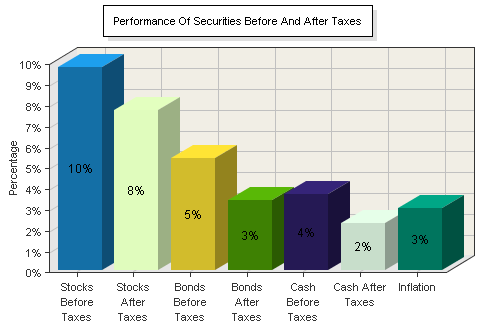Under the Economic Growth and Tax Relief Reconciliation Act of 2001, the federal estate tax was eliminated in 2010. The gift tax, however, remained in effect at a 35 percent rate. On Jan. 1, 2011, the estate tax returns. According to a new law enacted in December 2010, estates valued at $5 million or less are exempt from the tax. Estates worth more than $5 million are taxed at a 35 percent rate.
With the return of the estate tax in 2011, the stepped-up basis on inherited property also returned. This means that an asset's basis is its fair market value on the day of the original owner's death.
At death, your estate is subject to estate taxes that may reduce the estate's total assets. One of the crucial goals of Estate planning is to minimize potential taxes. Some of the taxes to consider are:
- Estate Tax: Tax levied on the estate itself that is required on estate transfers made at death. The taxable value is calculated on the price a buyer would pay for the assets being transferred. In the United States, estates are subject to both federal and state estate taxes.
- Inheritance Tax: Tax on the share of the estate going to each individual beneficiary.
- Federal Transfer Tax: All property that is transferred either by gift or death, during a lifetime or at death is subject to this tax.
- Gift Tax: It is any transfer to an individual, either directly or indirectly, where full consideration (measured in money or money's worth) is not received in return.
The following gifts are not taxable gifts:
- Gifts, excluding gifts of future interests, that are not more than the annual exclusion for the calendar year.
- Tuition or medical expenses you pay directly to a medical or educational institution for someone.
- Gifts to your spouse.
- Gifts to a political organization for its use.
- Gifts to charities.
The following table shows recent maximum Federal Estate tax rates in the United States:
| Year | Exclusion Amount | Highest Rate |
|---|---|---|
| 2002 | $1 million | 50% |
| 2003 | $1 million | 49% |
| 2004 | $1.5 millions | 48% |
| 2005 | $ 1.5 millions | 47% |
| 2006 | $ 2 millions | 46% |
| 2007 | $ 2 millions | 45% |
| 2008 | $ 2 millions | 45% |
| 2009 | $ 3.5 millions | 45% |
| 2010 | 0% | |
| 2011 | $ 5 millions | 35% |
Taxes Significantly Reduce Investment Returns This image illustrates how much the federal government withheld from one hypothetical investor following a simple long-term investment strategy (Stocks purchased held for five years, then sold, and the capital gains realized and reinvested. Dividends taxed when earned and reinvested. Bonds were turned over 27 times within the 84-year period). Comparing the after-tax return to the rate of inflation, you can see that if you invested solely in cash equivalents, you actually lost money in terms of purchasing power.  Source: StateTrust’s analysis of Morningstar data. Performance shown is not indicative of the performance of any specific investment. An investor cannot invest in an index, such as the one these graphs are based on. Past returns are no guarantee of future performance. These returns are based on historical information, from sources believed to be reliable, but accuracy cannot be guaranteed, and these returns can vary in future time periods.
Source: StateTrust’s analysis of Morningstar data. Performance shown is not indicative of the performance of any specific investment. An investor cannot invest in an index, such as the one these graphs are based on. Past returns are no guarantee of future performance. These returns are based on historical information, from sources believed to be reliable, but accuracy cannot be guaranteed, and these returns can vary in future time periods.
Objectives-Estate Planning